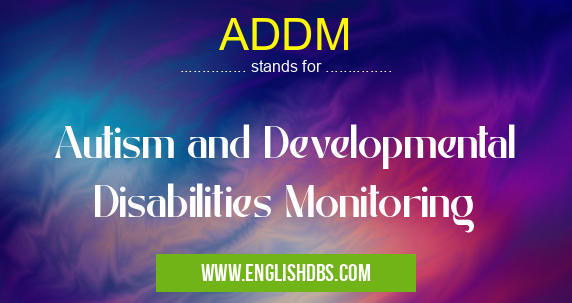What does ADDM mean in HOSPITALS
ADDM stands for Autism and Developmental Disabilities Monitoring. It is a program of the Centers for Disease Control and Prevention (CDC) supported by the Health Resources and Services Administration (HRSA). The program was established in 2000 and provides an estimated prevalence of autism spectrum disorder (ASD) among 8-year-old children in 11 communities across the United States. This information helps professionals, policy makers, and individuals better understand the public health burden of ASD, as well as inform services and interventions that can make a difference in helping families living with ASD.

ADDM meaning in Hospitals in Medical
ADDM mostly used in an acronym Hospitals in Category Medical that means Autism and Developmental Disabilities Monitoring
Shorthand: ADDM,
Full Form: Autism and Developmental Disabilities Monitoring
For more information of "Autism and Developmental Disabilities Monitoring", see the section below.
What is ADDM? The ADDM Network is a collection of 12 sites located throughout the United States that have been selected to collect data on autism spectrum disorders (ASDs) among eight-year-old children living in their area. These sites participate in two activities
case ascertainment – counting how many children have an ASD diagnosis; and data abstraction – collecting information from medical records about each case that has been identified. Together, these activities provide an estimated prevalence rate for ASD—the number of cases beyond what would be expected based on national estimates. This estimated prevalence rate helps professionals, policymakers, autism researchers, service providers, and families understand the public health burden of autism spectrum disorder in their community by providing more localized information than what can be obtained from national data alone.
Essential Questions and Answers on Autism and Developmental Disabilities Monitoring in "MEDICAL»HOSP"
What is Autism and Developmental Disabilities Monitoring?
Autism and Developmental Disabilities Monitoring (ADDM) is a surveillance program in the United States that collects information about the number of children with autism and other developmental disabilities. The ADDM Network uses data from the U.S. Department of Education’s Individuals With Disabilities Education Act (IDEA) programs to estimate the population prevalence of autism spectrum disorders (ASD) among 8-year-old children.
What does ADDM do?
The ADDM Network monitors changes in the population of children with ASD over time, identifies risk factors associated with ASD, and provides comprehensive estimates of the number of children with ASD in selected areas within 11 states across the United States.
Why are data collected about people with autism?
Data collected through the ADDM Network helps us to better understand how many individuals have been identified with an ASD and what factors may be associated with them. This information can be used by educators, healthcare providers, and policy makers to make informed decisions about services for individuals with autism spectrum disorder.
What is included in data collected by ADDM?
The data collected by ADDM includes characteristics such as gender, race/ethnicity, geographic location, age at evaluation, date of birth, type of disability diagnosed, etc. Information on educational environment prior to diagnosis and any special education services received after diagnosis are also collected when available.
Who oversees ADDM?
The Centers for Disease Control and Prevention (CDC) runs the ADDM Network along with state health departments and university partners who implement monitoring activities on a regional level using standardized methods developed by CDC.
Does participation in ADDM require parental consent?
Yes - parental consent is required for any public school students who participate in surveys or assessments as part of their involvement in IDEA programs that contribute data to ADDM.
How often does this surveillance take place?
Surveillance activities take place every two years (once for each 8-year age group). This means that if a child turns eight between October 1st and September 30th during odd-numbered years they will be part of one monitoring cycle; if they turn eight between October 1st – September 30th during even-numbered years they will be part of another monitoring cycle.
Final Words:
Overall, ADDM has proven to be invaluable resource for helping professionals better understand autism spectrum disorder by providing localized estimates instead of relying solely on national data alone which may not reflect regional variations in access to healthcare or cultural beliefs around diagnosis accuracy due to bias or lack of awareness about disability services. By allowing access to more detailed information about the epidemiology of ASD’s it allows stakeholders an unprecedented opportunity to assess public health needs more accurately when making decisions surrounding resource allocation which results in improved outcomes for individuals living with ASDs regardless of where they live.
